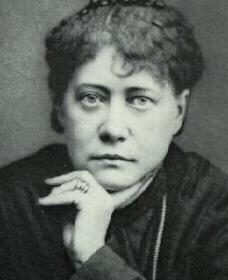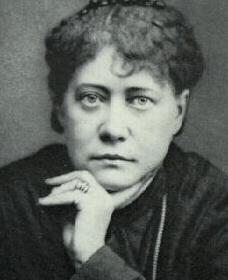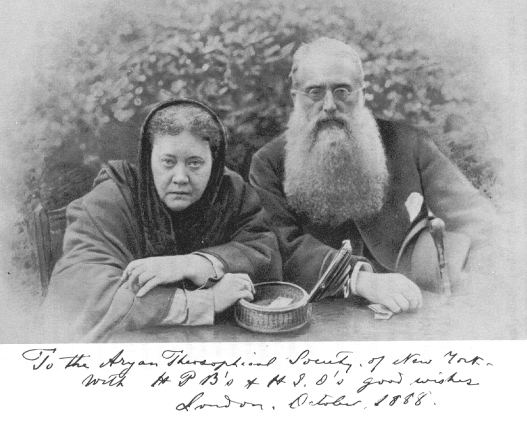Religious Figure. She gained recognition as the co-founder of Theosophy and a pioneer in esotericism. According to Merriam-Webster's Dictionary, Theosophy was a new religion established in the late 19th century in the United States based on the teachings of Madame Helena Blavatsky, a known Ukrainian mystic. Credited by some as the "godmother of the New Age movement," she was one of the first to introduce Eastern religions to the Western world, endorsing the ideas of karma and reincarnation. In the Russian Empire, she married a military officer in 1848 but left him within months. Abandoning her Christian upbringing, she followed her interest in the occult. For many years, she traveled extensively throughout Asia, Europe, and the United States. She claimed to have studied for many years in India and with Tibetan mystics on the subject of Hindu and Buddhist teachings. She developed into a charismatic anti-establishment figure. By 1873, she was in New York City, and in 1875, she co-founded the Theosophical Society with Henry Steel Olcott and launched the Theosophical Movement, calling her message Theosophy. She was the author of several massive books, including the 1,300-page "Isis Unveiled" in 1877 and the 1,500-page "The Secret Doctrine" in 1888. Her "Collected Writings" were published in 15 volumes between 1950 to 1991. In 1879, Blavatsky and Olcott traveled to India and, in 1881, established the Theosophical Society headquarters at Adyar, near Madras, and began publication of the society's journal, "The Theosophist," which Blavatsky edited from 1879 to 1888. Claiming that she possessed extraordinary spiritualist powers, critics declared her a fraud in 1885. Eventually, after an investigation by the Society for Psychical Research in Cambridge, she left India after the incident for Germany, Belgium, and finally, England, remaining there the rest of her life but continuing her writings. Even with the negative publicity, she had devoted disciples. An interest in her teachings rallied with the New Age Movement at the end of the 20th century. According to the Theosophical Society, her remains were cremated, with her ashes being divided between New York, London, and India, where the ashes are interred under her statue in Adyar.
Religious Figure. She gained recognition as the co-founder of Theosophy and a pioneer in esotericism. According to Merriam-Webster's Dictionary, Theosophy was a new religion established in the late 19th century in the United States based on the teachings of Madame Helena Blavatsky, a known Ukrainian mystic. Credited by some as the "godmother of the New Age movement," she was one of the first to introduce Eastern religions to the Western world, endorsing the ideas of karma and reincarnation. In the Russian Empire, she married a military officer in 1848 but left him within months. Abandoning her Christian upbringing, she followed her interest in the occult. For many years, she traveled extensively throughout Asia, Europe, and the United States. She claimed to have studied for many years in India and with Tibetan mystics on the subject of Hindu and Buddhist teachings. She developed into a charismatic anti-establishment figure. By 1873, she was in New York City, and in 1875, she co-founded the Theosophical Society with Henry Steel Olcott and launched the Theosophical Movement, calling her message Theosophy. She was the author of several massive books, including the 1,300-page "Isis Unveiled" in 1877 and the 1,500-page "The Secret Doctrine" in 1888. Her "Collected Writings" were published in 15 volumes between 1950 to 1991. In 1879, Blavatsky and Olcott traveled to India and, in 1881, established the Theosophical Society headquarters at Adyar, near Madras, and began publication of the society's journal, "The Theosophist," which Blavatsky edited from 1879 to 1888. Claiming that she possessed extraordinary spiritualist powers, critics declared her a fraud in 1885. Eventually, after an investigation by the Society for Psychical Research in Cambridge, she left India after the incident for Germany, Belgium, and finally, England, remaining there the rest of her life but continuing her writings. Even with the negative publicity, she had devoted disciples. An interest in her teachings rallied with the New Age Movement at the end of the 20th century. According to the Theosophical Society, her remains were cremated, with her ashes being divided between New York, London, and India, where the ashes are interred under her statue in Adyar.
Bio by: Linda Davis
Gravesite Details
Part of ashes interred under her statue in Adyar.
Family Members
Advertisement
See more Blavatsky memorials in:
Records on Ancestry
Advertisement





